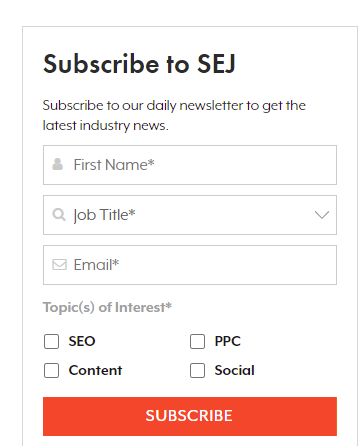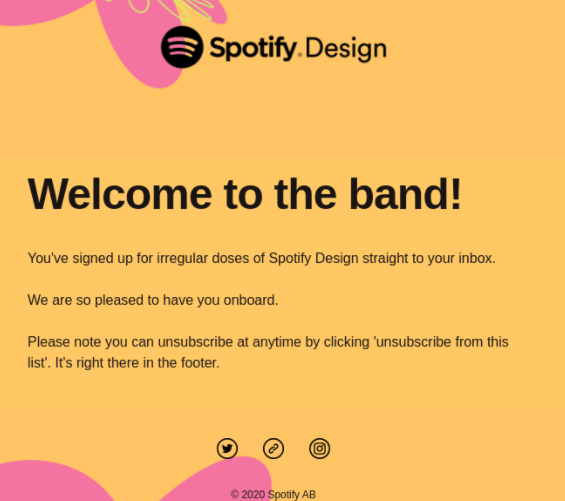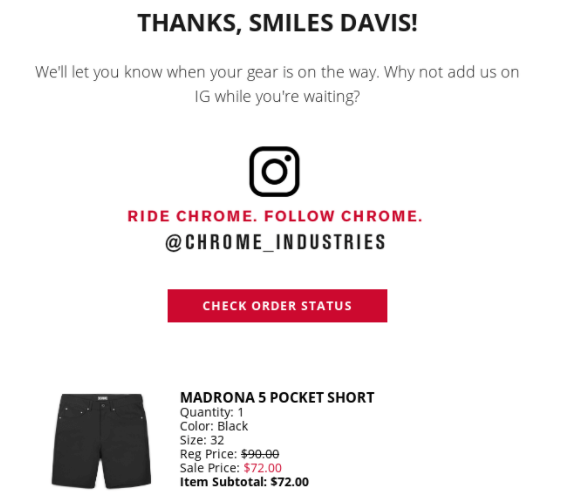
Is email marketing dead?
With all the talk of video, artificial intelligence, virtual reality, and chatbots, it sometimes seems like email is long past its prime.
But if you think email is dead, you’re missing out on the real metrics. The truth? Email marketing is still going strong and is possibly the best possible strategy to grow your business.
The proof?
Email marketing is still ranked as the most effective marketing channel, beating out social media, SEO, and affiliate marketing.
Why is that? With all the hype over new channels, why is decades-old technology still one of the most effective marketing strategies?
Despite the rise of social, people use email more than other platforms. After all, what’s the good of marketing to someone if they’re not there?
Data shows that most people are on email—and the number increases every year.
In addition, with email marketing you own the connections — you don’t have to worry about algorithm changes tanking your reach.
That’s why building a successful email marketing campaign is more important than ever.
But there’s a problem—most people don’t know how to do it right. (In fact, you’ve probably seen those people in your email box.)
Today, you’ll learn exactly how to start an email marketing campaign from scratch.
Remember—You’re a Guest in Their Inbox
People are inundated with interruptions, pitches, and advertisements everywhere they look.
Though you might think your email is special. But to the reader, your email is one in a million — and not in a good way.
This is why it’s important to remember where you are and use good manners.
Getting into someone’s inbox is like being invited to their home for dinner. If they ask you to take your shoes off, you respectfully do so.
It’s the same with email marketing, so before we begin I’d simply like to remind you to be on your best behavior at all times and remember… you’re a guest in their inbox.
Now, let’s talk about how to build your email marketing strategy from the ground up.
Email Marketing Step 1: Build Your List
Before you can start sending out emails, you need people to send emails to. So, how do you get started building your list? Start by adding a banner or form to your website simply asking people to subscribe.
Then, follow these tips.
Offer an Incentive
Think of email addresses as a currency — you wouldn’t give money away for free, right? Offering an incentive is the simplest way to gather email address.
There are many ways you can do this, of course. Some prefer to give something away for free while others simply offer a newsletter or product updates.
For example, the business newsletter Morning Brew offers readers a simple benefit—their fun, interesting updates every morning.
Search Engine Journal uses a small form in their right side bar offering daily news — they also ask about what topics they user is interested, which helps them send more valuable content.

You can also offer a checklist, ebook, white paper, or another downloadable asset. Contests and giveaways are another great way to convince people to share their email addresses.
I can’t tell you which is the right or wrong path for your business, but I can tell you that it’s important to have a clear purpose when asking for an address.
This is where a strong call to action comes into play, and copywriting is super important.
Establish your credibility, explain what the emails are for, and get people interested in receiving them.
Simply posting “enter your email for updates” isn’t going to get anyone excited. Instead, share specifics.
By sharing a specific call to action or benefit to providing their email address, you can get more people to subscribe.
Some common ways to entice people to sign up include:
- email series
- free downloads
- free white papers or eBooks
- update lists, like new releases and product updates
Whatever that incentive is, make it clear and enticing, and don’t be afraid to promote it.
Follow Email Marketing Laws and Regulations
You’ll also want to make sure your emails follow local rules and regulations, including CAN-SPAM and GDPR.
Don’t let all the legalese scare you — just make sure you never buy email lists and consider using double opt-in options so people know what they are getting into. Finally, make it easy for people to unsubscribe.
Email Marketing Step 2: Provide Great Content
Email marketing is all about expectations, and it’s up to you to set them.
If your call to action is strong, and your follow-up is consistent, then you can count on a successful email campaign.
However, if you promise to send one email per week and instead send them daily, then you’re setting yourself up for failure.
On the contrary, if someone is expecting daily updates or critical product updates and you don’t deliver, then they are likely to be just as upset in that case, too.
This is why the first follow-up email is so crucial to the success of your email marketing efforts.
Send Out An Introduction Email
For example, here’s a basic welcome email from Airbnb to a new host. It explains the basics of the process and what you can expect to receive from Airbnb.
Spotify sends out a similar email that confirms the subscription and lets them know what they can expect.

Almost all email service providers give you the option to create an automated welcome sequence, and so take advantage of it.
The initial follow-up email should be sent immediately as a way to introduce yourself and detail what you plan on doing with your new subscriber’s email address.
It’s better to be long-winded and detailed than it is to be quick and unobtrusive, but if you can pull off quick and concise, then more power to you.
From here, it’s simply a matter of living up to their expectations.
Don’t Pitch Right Away
You’re not running an email list just for the fun of it—you’re there to engage customers and make sales.
But transitioning from an email list that provides tons of free value into a list that pitches a product for money can be a tricky switch to make.
To do it effectively, it’s a good idea to think in advance about your pitching. You don’t want to surprise everyone with a pitch all of the sudden.
You’ll have a much more successful campaign if people expect sales pitches every once in a while.
If you’re going to get in the habit of selling often, try to put yourself in the reader’s shoes.
Ask yourself if your messaging is consistent with the expectations you’ve set. If possible, understand what the customer has shown interest in before, and send similar offers down the line.
Those that send blind offers are far more likely to lose permission to keep doing so.
Again, each business has different needs, and there aren’t any hard and fast rules as to how often you can pitch or provide content.
Just remember that an email list is a permission asset and it’s better to err on the side of caution than to play it loose and reckless.
How to Write a Great Email Newsletter
Let’s talk about the difference between a good newsletter and a bad newsletter.
The first sign that you’ve received a bad newsletter is that you don’t recall ever asking to receive it.
Typically, this happens when a business either fails to maintain a regular email routine or manually adds someone to their list after receiving a business card or personal email.
Make sure everyone remembers you—the best way to do this is not to let your emails lapse for too long. Try to send at least one a month, or once a week if you can.
I find the most compelling newsletters are those that do a great job of mixing messaging and updates.
For example, while the email might contain a list of product updates and images, it’s balanced by a personal message or friendly memo.
Use your newsletter as a way to further your relationship with the reader/customer rather than to pitch them.
Save the pitch for unique updates, offers, and announcements.
Use Email Automation Carefully
If you’re just starting out with an email list, it’s easy to imagine you’ll have time to personally respond to every new subscriber.
But once you start getting more than a handful of subscribers, it becomes next to impossible to keep up.
You’ll start to get more and more complex campaigns, and following through with everyone all the time is impossible.
Yet top marketers seem to do this exact thing. How?
Their secret is email automation.
It automatically sends out emails that you schedule in advance.
By scheduling a set of emails to send in advance, you can prevent “going dark” for any length of time.
Oftentimes, companies plan out a series of emails—ranging from a few days to a few months—that automatically deliver, warming up anyone who signs up for your list.
That way, when you do need to announce a new product or sale, you can count on the fact that they are paying attention.
Since you’ve built up a relationship over several weeks or months, you’re much less likely to annoy your readers.
Email Marketing Step 3: Analytics and Segmentation
Now that you understand the basics behind an effective email campaign, let’s talk about how to take things to the next level.
Specifically, using segmentation and analytics to refine your broadcasts and generate even better results than a basic campaign.
How to Understand Email Analytics
We’ve talked before about the importance of analytics in web copy, and email is no different.
Every email service provider I’ve ever worked with provides complimentary analytics.
Though they’re all important, the three most important are open rate, click-through rate, and unsubscribes. Let’s break down each one and see what there is to learn from it.
First, your open rate explains how many people open your emails. It’s based on a single invisible tracking pixel that loads when someone clicks on your message.
When looking at open rates, it’ll usually tell you how well you’ve built your relationship with readers. Ideally, people are excited to read your emails and open them quickly.
If your open rate is low, it usually means you have a lot of unengaged subscribers. You need to work harder on providing value and managing expectations. Here are a few tips on raising your open rate.
Next, your click-through rate, or CTR, shows how many people clicked on a link (if any) in your email.
If your CTR is low, it means that your message is either not targeted enough, or simply not getting through. In this case, focus on improving your copy.
Finally, your unsubscribe rate tells you how many people have clicked the “unsubscribe” button at the bottom of your email.
If your unsubscribe rate is high in relation to your opt-in rate, then you’ve passed the point of building value and writing good copy… you’ve got some serious work to do.
Essentially you’ve built a sieve and people that sign up eventually leave. If this is you, try to examine when people are leaving and take action based on those leaks.
If they’re leaving after a certain automated email, then re-work it. If they’re leaving after marketing messages, then re-work the way you present offers.
If they’re leaving early on in your email funnel, then you need to fix your original call to action so that it’s in harmony with what you’re sending.
Email analytics are critical because, if you’re paying attention, they’ll give you very specific clues as to what you’re doing wrong.
Of course, the key here is “paying attention.”
How to Segment Your Email Marketing List
If you’re unfamiliar with the term, email segmentation is the practice of splitting up your email list into more targeted groups.
Here’s a few ways to segment a larger list:
- customer list (in comparison to leads who haven’t bought)
- newsletter subscribers
- daily email list (in comparison to weekly, bi-weekly, monthly, etc)
- demographics, such as age, location, or job title
- interests, such as marketing or sales topics
Just like targeting in paid ads, dividing your list gives you the ability to send more targeted communications.
For example, some customers want both product and sales updates, while others might only want to hear about new versions. Sales team leads might want to hear about a new sales feature but not a new marketing tool.
Plus, you can send specific emails to buyers thanking them for their purchase, like this email from Chrome Industries thanking people for making a purchase.

With segmentation, you can send a broadcast only to those that didn’t open your last message (ask them why), or to those that showed interest (a second pitch).
You can also split test messaging amongst different groups in order to A/B test titles, content, or best practices.
As you can see, segmentation isn’t rocket science, but it is work, which is why most don’t take the time to do it right.
If you do, you’ll immediately separate yourself from the pack.
How Much is Your Email List Worth?
Your email list is one of your most valuable resources, and if you learn how to treat it right, it will pay for itself many times over.
Over time, you can start tracking how much money people on your list spend on average. This will tell you how much your list is worth.
If a list of 10,000 people usually spends $50,000 on a campaign, and you run two of those campaigns each year, you could average it out and say that each subscriber is worth $10 a year.
When you do the math like that, it is easy to see how losing several hundred subscribers could be dangerous to your bottom line.
Conclusion
If you’ve been ignoring email marketing, it’s time to reevaluate your strategy.
Email marketing delivers huge returns for marketers willing to learn how to do it right. It doesn’t have to be too complicated.
First, remember you’re a guest in the inboxes of your subscribers. Your emails are always just one click away from losing their interest forever. Be polite, respectful, and deliver value.
As you get started, you’ll need to ask permission. Of course, it’s the right thing to do. But in the era of new data protections, like the EU’s GDPR, it’s also a legal requirement.
You’ll want to follow through with the promises you make. Provide people what they’ve asked for and email on a regular basis that lines up with their expectations.
There’s no formula for boosting email automation—it’s all about what works best for you and your company’s voice and style.
Finally, you can move on to email segmentation and analytics once you’ve mastered the basics. Start sending separate types of emails to different groups of people so you can deliver more useful emails.
What email marketing practices keep your readers engaged?
The post A Beginner’s Guide to Successful Email Marketing appeared first on Neil Patel.
from Blog – Neil Patel https://ift.tt/2xuBOjP
via IFTTT
No comments:
Post a Comment